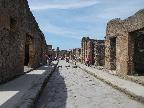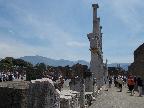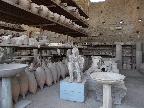Pompeii
A brief history of the city
The origins of Pompeii date from the 8th Century BC when it was founded by the Osci, one of the oldest of the Italic peoples. It was built at the end of an ancient lava flow, 130 feet above sea level, on the mouth of the River Sarno. Lying on a route North to South, between the sea and the fertile valleys inland, it quickly became an important road route and port, attracting the attention of surrounding powerful States. It was subjugated by Cumae, a Greek state, who were ousted by the Etruscans between 525 and 474 BC and then, towards the end of the fifth century BC, the Samnites, Oscan speaking people, seized control. In 310 BC the Samnites were overtaken by the Romans and it became an emerging Roman state. When it joined the Italic revolt against Rome it was brutally crushed by Sulla, the founder of the Roman Republic, becoming a colony named after him, ‘Colonia Veneria Cornelius P’.
These different conquerors left behind their customs and artworks in the city, in particular those of
the Samnites. Many of the artworks were taken from the city, some of which were used to found the Naples Museum.
I visited Pompeii in May 2017 and was overwhelmed by the number of buildings and artefacts that had survived after the colossal eruption of 79AD, particularly moving were those used in everyday life by the people inhabiting or visiting the City.
 |  |  |
The great eruption was not the first disaster to strike the City as the earthquake of 62 AD had reduced it to rubble. The citizens rebuilt, it rose again from the ruins and was extended. This process was ongoing when Vesuvius erupted causing a huge cloud to black out the sun. Red hot volcanic matter, followed by ash mixed with water, and poisonous gases, extinguished all forms of life in Pompeii as far as Herculaneum to the West and Stabiae to the South East. These events were followed by lightening, earthquakes and tidal waves and all continued for several days until what had been Pompeii lay buried under 15 to 20 ft deep volcanic material. Vesuvius remained active for many centuries, up to modern times. Looters carried off valuable material from the surface then other cities were built around the site. Although several attempts at excavation were made over subsequent times, fear of collapse, and of the site itself, eventually rendered the city, to all intents and purposes, forgotten.
 |  |  |  |
After a period of 1600 years the first ruins were uncovered but a further 150 years passed before the full extent of the city was rediscovered.
It was the work of Guiseppe Fiorelli, beginning in 1860, which aided the wonderful state of preservation of the site. He carried out systematic and careful excavations and was the first person to obtain impressions of human, animal and plant material. He employed a process of pouring plaster of Paris into spaces left by these organic substances which had decomposed after the volcanic ashes solidified.
Preservation and restoration work continued and, from 1909, under the direction of Vittoria Spinaloza, many buildings were discovered in remarkable states of preservation due to the depth of volcanic ash under which they had lain buried. Wandering around the streets of this ancient city, which had lain buried for almost 2,000 years, visitors may now observe the Amphitheatre, built in 80 BC, houses both modest and fine with their richly painted decorations, bath houses and laundries, shop fronts and everyday articles used by citizens and visitors to the city in their daily lives.
The work continues to reveal the remaining part of the city, estimated to be about one quarter, so
that visitors may continue to come and observe and marvel at the remains of the City of Pompeii.
Bibliography: (a couple of examples of what is available)
Pompeii: 2000 years ago and today, by Alberto C. Carpiceci
Pompeii: The life of a Roman town, by Mary Beard
Further reading is also available on Wikipedia
Marie Embry
Back to Armchair travellers page
